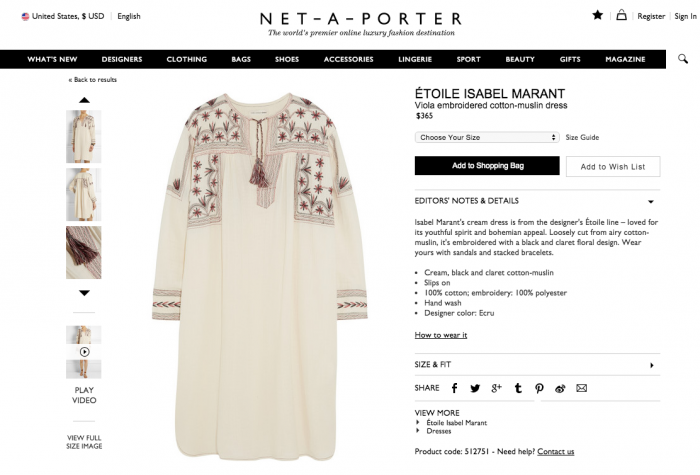When designer Isabel Marant sent her spring/summer 2015 "Étoile" collection down the runway last year, she had no idea that the designs--which she later claimed were "inspired by" Mexico's indigenous Mixe community--would spur that community to action against her for plagiarism. After a year that included social media outcry, protests at Marant's New York store and a press conference held by the Mixe people, the group is finally getting some semblance of justice.
This month, Oaxaca’s congress declared the Mixe community's traditional designs and language as Intangible Cultural Heritage per UNESCO guidelines. The protected status is not legally binding, but it recognizes that the designs are unique to, and originate in, Mixe culture.
Residents of Santa Maria Tlahuitoltepec, in the southwestern state of Oaxaca, claimed that Marant ripped off the traditional red-and-white embroidery of the Mixe people. To Marant's credit, she admitted that the design was originally theirs and pulled the blouse from sale last year. But did so only after artisans, community members and entertainers voiced outrage that Marant, and fellow French label Antik Batik, failed to acknowledge the design's origins.
The shirt, known as a "huipil," is a 600-year-old traditional design of several indigenous communities in Mexico and Central America. Marant's version retailed for as much as $365. Last year, the indigenous rights nonprofit Impacto invited her to visit the Mixe and learn how the blouse was important to their history, according to the Guardian.
But separately, Antik Batik tried to lay its own copyright claims to the design, and accused Marant of copying them. In December 2015, a French court ruled that neither Isabel Marant nor Antik Batik could copyright huipil shirts because they were a cultural artifact of the Mixe people.
Oaxaca's recent cultural heritage declaration explicitly cites Marant's design from July 2015 as an impetus for action. It states that "she presented, as her own, a traditional blouse of the community of Santa Maria Tlahuitoltepec... and the trial was initiated to protect the garment against a company that wanted to infringe the patent of a traditional design and exploit it for commercial purposes."

This isn't the first time the fashion world has confronted cultural appropriation in recent years. There were last year's "Africa-inspired" Valentino show featuring a mostly-white model cast, and Victoria's Secret's infamous outfitting of model Karlie Kloss in a string bikini and a Native American headdress. On the opposing end, Brazilian designer Oskar Metsavaht showed an innovative solution to the issue when he paid royalties to the Amazonian tribe who inspired designs for his Osklen line.
Cultural appropriation is a perennial hot-button issue in the fashion industry, and while it's true that inspiration from various sources is part of any design process, cultural appropriation is specifically about a power imbalance. "There is always an inherent power imbalance — it is the dominant group taking from a marginalized group," Dr. Adrienne Keene, of the blog Native Appropriations, tells Refinery 29.
Oaxaca's decision to recognize Mixe embroidery as cultural heritage is an important symbolic step, but since it is not legally binding, its impact will depend on its enforcement.
"The UNESCO definition largely has no teeth," Dr. Jane Anderson an anthropology professor at NYU, told the Huffington Post. "While the Oaxaca congress made this declaration, that does not make it legally binding, because Mexico a) is not a signatory to UNESCO's 2003 Convention for the Safeguarding of Intangible Cultural Heritage and b) Mexico has not submitted the Mixe's 'intangible heritage' to the Convention Committee for approval to list."
This doesn't mean it's useless: protection is not as good as a law, but it's better than nothing. It may be enough to deter people from copying the design again, said Anderson.
Thus, the impact of Oaxaca's declaration will depend on the ongoing engagement of the Mixe community with the fashion world -- a big, potentially exhausting task. The Mixe's unique designs are their intellectual property, and in an ideal world, they should have the right to economically benefit from them. But Anderson said Marant's case was somewhat unique because of the outsize media outcry. "The media attention made it a liability and not a lucrative venture," she said.
What's the way forward from here?
"What would be nice, given that the fashion industry is full of appropriation of indigenous designs, would be the development of some kind of industry standard," suggested Anderson. "It is possible to get change, it just takes a while."
